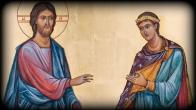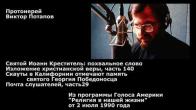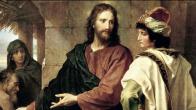You are here
March
- February 21/March 6-- "Kozelshchanskaya"
- February 23/March 8 --"Cyprus" (Stromyn) Icon
- February 27/March 12 -- Lydda Icon "Not Made by Hands"
- February 28/March 13 -- "Devpeteruvskaya"
- March 2/15 -- "Reigning"
- March 6/19 -- "Chenstokhovskaya", "Shestokovskaya" or "Sheltomezhskaya"; "Blessed Heaven"
- March 9/22 -- "Albazin" Icon "The Word Was Made Flesh"
- March 14/27 -- St.Theodore ("Feodorovskaya")
"Kozelshchanskaya" Icon
21 February / 6 March
 The "Kozelschanskaya" icon of the Mother of God was glorified following an unusual miracle which happened to the family of Count V.I. Kapnist, who lived in the village of Kozelschina, in the province of Poltava. In 1880, his daughter suffered a leg sprain and was unable to walk. Renowned physicians of Poltava and Moscow suggested that she be referred to the luminaries of Europe. Hoping to receive help from the famous Frenchman Charcot, who was expected shortly in Moscow, the Count decided to take his daughter there. On the eve of their departure, the Countess told her daughter that she should pray fervently before their family holy icon of the Mother of God. The daughter cleaned the icon’s riza, and in a fervent stream of tears poured forth her complete faith. Suddenly she perceived that something miraculous was happening. A feeling of vitality appeared in her arms and legs, a strength which until that moment she did not have. Involuntarily, she cried out “Mama, mama, I feel my legs, I feel my arms!” At first the mother thought that her daughter had taken leave of her senses; the abruptness of her movements, the joy in her face, and her cries appeared to the suffering mother to be symptoms of an attack of madness. However, the Countess came to see that her daughter had been miraculously healed. Despite this, the Countess took her daughter, along with the icon, to Moscow. The physicians, including the renowned Charcot, declined to express a scientific explanation for what had occurred. Charcot stated that were it not for the presence of trustworthy witnesses like the Muscovite professors, he would have considered it all a fabrication.
The "Kozelschanskaya" icon of the Mother of God was glorified following an unusual miracle which happened to the family of Count V.I. Kapnist, who lived in the village of Kozelschina, in the province of Poltava. In 1880, his daughter suffered a leg sprain and was unable to walk. Renowned physicians of Poltava and Moscow suggested that she be referred to the luminaries of Europe. Hoping to receive help from the famous Frenchman Charcot, who was expected shortly in Moscow, the Count decided to take his daughter there. On the eve of their departure, the Countess told her daughter that she should pray fervently before their family holy icon of the Mother of God. The daughter cleaned the icon’s riza, and in a fervent stream of tears poured forth her complete faith. Suddenly she perceived that something miraculous was happening. A feeling of vitality appeared in her arms and legs, a strength which until that moment she did not have. Involuntarily, she cried out “Mama, mama, I feel my legs, I feel my arms!” At first the mother thought that her daughter had taken leave of her senses; the abruptness of her movements, the joy in her face, and her cries appeared to the suffering mother to be symptoms of an attack of madness. However, the Countess came to see that her daughter had been miraculously healed. Despite this, the Countess took her daughter, along with the icon, to Moscow. The physicians, including the renowned Charcot, declined to express a scientific explanation for what had occurred. Charcot stated that were it not for the presence of trustworthy witnesses like the Muscovite professors, he would have considered it all a fabrication.
With the icon, the Count’s family departed for their estate. Soon thereafter, a blind maiden appeared and told them that in a dream, the Mother of God had told her to come to her icon. The Countess brought out the icon, and the maiden prayed before it for a long time. Several days later, she regained sight in both eyes. First a chapel, and then a church, were built in the Count’s garden. In 1885, a women’s monastery, with a hospital, school, and home for the crippled, was opened in Kozelshchina.
The Cyprus Icon in the village of Stromyn
23 February / 8 March
![]() The village of Stromyn is not far from the city of Moscow . Not far from that village in the 14th century, Venerable St. Sergius of Radonezh established a monastery which came to be known as the Stromyn Monastery of the Dormition. In 1764, by order of the Holy Synod, the Monastery was closed. Its buildings were torn down, and its church became a parish church. In 1827, the old parish church of the village of Stromyn was torn down, and on its site parishioners erected a beautiful new stone church dedicated to the Dormition of the Mother of God, with two side chapels – to St. Sergius of Radonezh and to St. Nicholas. The now miraculous Icon of the Mother of God rests in that church of the Dormition. In 1841, the Icon was glorified in the following manner:
The village of Stromyn is not far from the city of Moscow . Not far from that village in the 14th century, Venerable St. Sergius of Radonezh established a monastery which came to be known as the Stromyn Monastery of the Dormition. In 1764, by order of the Holy Synod, the Monastery was closed. Its buildings were torn down, and its church became a parish church. In 1827, the old parish church of the village of Stromyn was torn down, and on its site parishioners erected a beautiful new stone church dedicated to the Dormition of the Mother of God, with two side chapels – to St. Sergius of Radonezh and to St. Nicholas. The now miraculous Icon of the Mother of God rests in that church of the Dormition. In 1841, the Icon was glorified in the following manner:
A certain eighteen-year-old woman named Martha, daughter of a peasant of Stromyn, fell ill with scrofula and scurvy. With the passage of time, her condition worsened. By early 1841, the sick young woman was in horrible condition, suffering attacks so powerful that her life was in danger. Martha’s friends and relatives were already sure that she would die. On January 7, she was confessed and communed of the Holy Gifts. However, God’s mercy prevented her death. The Merciful Lord did not allow her to die in the bloom of her youth. She began to have dreams in which she could see the Cyprus Icon of the Mother of God standing above the entrance doors of their parish church. Martha would hear a voice coming from the Icon, saying “Take me into your house, serve a Moleben with the Blessing of the Waters, and you will be well.” She told her friends and relatives of the visions she had had during the night. More than once, she asked the priest and other clergy about this Icon, but they could not find it, for they almost never took note of the place where it was ultimately found. They brought the sick woman to the church, so that she herself might look for the Icon she had seen in her dream. For a long time, her search was unsuccessful. Finally, she went out onto the courtyard before the church, and above the entrance doors, saw an ancient icon of the Theotokos. Upon seeing the Icon, the sick woman joyously cried out, “There she is!” On February 16, the sick woman’s father invited the priest to bring the Icon of the Mother of God to his house. After a Moleben with the Blessing of the Waters was served, the sick woman immediately felt relief from her sicknesses. She became so much stronger that after the Moleben she herself carried the Icon into the church. Soon she was completely well.
When the Stromyn villagers heard that young Martha had been miraculously healed by prayers before the Cyprus Icon of the Mother of God, they began to gather in great numbers at the church for Molebens before the glorified Icon. Grace-filled power exuded from it and healed all those who offered up their prayers in humility and hope in the Theotokos’ intercession before God. Not only parishioners from the village of Stromyn, but people from the surrounding area would come in great numbers as well.
The Icon is decorated with a rich gilded riza. The Icon depicts the Mother of God seated on a throne, with a royal crown upon her head. The Pre-eternal Infant is bareheaded and holds His right hand in an attitude of blessing.
Lydda Icon "Not Made by Hands"
25 February/12 March
When the Holy Apostles Peter and John the Theologian were preaching Our Lord Jesus Christ in the city of Lydda, not far from Jerusalem, there was erected for the newly converted a church dedicated to the Most-holy Theotokos. Coming to Jerusalem, the apostles asked the Mother of God to visit, and by her presence to consecrate and bless the church. The Most-holy Virgin declared: "Go in peace, and I will be there with you as well." Returning to the church, they saw on one of the support columns a marvelously beautiful image of the Most-holy Theotokos, "Not Made by Hands." Later, the Mother of God visited the Lydda church and bestowed upon Her image special grace and power.
During the reign of the emperor Julian the Apostate (361-363), a new miracle occurred in Lydda. Stone masons were sent to obliterate the miraculous image. However, no matter how they tried to erase the sacred image, it did not disappear, but instead penetrated deeper into the column. The glory of the grace-filled image spread throughout the world. A copy which was taken to Rome and which also received miraculous power is celebrated on 26 June, N.S.
Another Lydda Icon of the Mother of God "Not Made by Hands" exists. It is in a church erected in Lydda by Aeneas, who was healed by the Holy Apostle Peter (Acts 9:32-35). At the direction of the ruler, at a time when the Jews and pagans were bent on wresting the church from the Christians, the church was locked up for three days in anticipation of a sign by which to settle the dispute. When, three days later, the church was re-opened, everyone saw in it an image of the Mother of God "Not Made by Hands."
In an epistle addressed to the iconoclast Emperor Theophilus (829-842), the Patriarchs of Jerusalem, Antioch and Alexandria wrote about both of the Lydda "Not Made by Hands" icons. The Emperor Constantine VII Porphyrogenitus (912-959) mentions this epistle in his historic sermon about the Edessa Image of the Savior "Not Made by Hands."
Devpeteruvskaya Icon
28 February /13 March
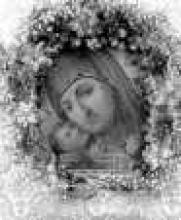 This Icon miraculously appeared in 1392, and was housed in the Church of St. Nicholas the God-pleaser near Moscow. A miraculous copy in Tambov came to be called the Devpeteruvskaya-Tambov Icon of the Mother of God. This Image of the Mother of God was the cell Icon of Holy Hierarch Pitirim of Tambov. After Holy Hierarch Pitirim's blessed repose, the Icon was placed above the reliquary housing his relics in the Holy Transfiguration Cathedral. It gained particular renown in 1833, following the miraculous liberation of a certain person who, on the basis of a false accusation against him, had been imprisoned. St. Pitirim appeared to the man's wife, and directed that a moleben be served before his cell icon. The woman obeyed the Holy Hierarch's order, and soon thereafter, her husband was released from prison.
This Icon miraculously appeared in 1392, and was housed in the Church of St. Nicholas the God-pleaser near Moscow. A miraculous copy in Tambov came to be called the Devpeteruvskaya-Tambov Icon of the Mother of God. This Image of the Mother of God was the cell Icon of Holy Hierarch Pitirim of Tambov. After Holy Hierarch Pitirim's blessed repose, the Icon was placed above the reliquary housing his relics in the Holy Transfiguration Cathedral. It gained particular renown in 1833, following the miraculous liberation of a certain person who, on the basis of a false accusation against him, had been imprisoned. St. Pitirim appeared to the man's wife, and directed that a moleben be served before his cell icon. The woman obeyed the Holy Hierarch's order, and soon thereafter, her husband was released from prison.
Devpeteruvskaya Icon in Tambov
28 февраля/13 марта
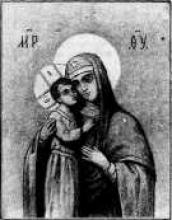 В Кафедральном Тамбовском соборе находится икона Божией Матери Девпетуровской, особенно чтимая прежде в Тамбове, потому что она, по преданию, была келейной иконой Святителя Питирима, Тамбовского чудотворца. Перед ней св. Питирим воссылал теплые молитвы к Богу. Эту икону особенно стали чтить с 1833 года, вследствие одного чудесного события. Одна женщина, у которой муж, вследствие ложного обвинения, был заключен в тюрьму, видела во сне неизвестного старца, который приказал ей отыскать в соборе келейную икону свт. Питирима (икону Божией Матери Девпетуровской) и перед ней отслужить молебен. Основываясь на описании старцем иконы и ее вида, женщина с первого взгляда при показе ей иконы объявила, что эта именно та икона, которая была показана ей во сне. Она просила отслужить перед ней молебен, и действительно, в скором времени муж этой женщины был освобожден из тюрьмы.
В Кафедральном Тамбовском соборе находится икона Божией Матери Девпетуровской, особенно чтимая прежде в Тамбове, потому что она, по преданию, была келейной иконой Святителя Питирима, Тамбовского чудотворца. Перед ней св. Питирим воссылал теплые молитвы к Богу. Эту икону особенно стали чтить с 1833 года, вследствие одного чудесного события. Одна женщина, у которой муж, вследствие ложного обвинения, был заключен в тюрьму, видела во сне неизвестного старца, который приказал ей отыскать в соборе келейную икону свт. Питирима (икону Божией Матери Девпетуровской) и перед ней отслужить молебен. Основываясь на описании старцем иконы и ее вида, женщина с первого взгляда при показе ей иконы объявила, что эта именно та икона, которая была показана ей во сне. Она просила отслужить перед ней молебен, и действительно, в скором времени муж этой женщины был освобожден из тюрьмы.
В настоящее время копия с этой иконы постоянно лежит на аналое слева от мощей свт. Питирима в Кафедральном Соборе. Подлинник же – келейная икона свт. Питирима, которая чудом сохранилась до наших дней, – выносится для поклонения верующих в большие праздники при службе архиерейским чином.
The Miraculous "Reigning" Icon
2/15 March
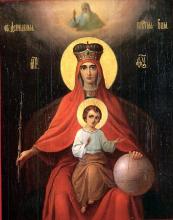 The Miraculous "Reigning" Icon of the Mother of God was discovered on the day of the abdication of Emperor-Martyr Nicholas II from the throne, 2/15 March 1917. The Russian People saw it as evidence that supreme authority over Russia, and the responsibility for assisting Russia, had been transferred to the Queen of Heaven.
The Miraculous "Reigning" Icon of the Mother of God was discovered on the day of the abdication of Emperor-Martyr Nicholas II from the throne, 2/15 March 1917. The Russian People saw it as evidence that supreme authority over Russia, and the responsibility for assisting Russia, had been transferred to the Queen of Heaven.
On two separate occasions, the Most-holy Theotokos appeared to the peasant woman Eudokia Adrianovna in a dream. On February 13, 1917, Eudokia heard the Theotokos say the following words, "In the village of Kolomenskoye, there is a large black icon. It has to be taken – let people pray [before it]." On February 26, she had a vision of a white church, within which there sat enthroned a majestic Woman. The peasant woman decided to seek out the church she had seen in her dream. On March 2, in the village of Kolomenskoye, near Moscow, she recognized the Church of the Ascension as the very one she had seen in her dream. After an conducting an exhaustive search, she and the parish rector found a large, dark icon of the Mother of God in the church basement; it was the very Icon that had been revealed to Eudokia [in her vision].
People immediately began to revere the Icon as miraculous. Many copies of the Icon were made, and It was invited to be brought for prayer services to all of the surrounding villages, and to many monasteries, churches, and factories and manufacturing plants all over Moscow. St. Tikhon, Most-holy Patriarch of Moscow and All Russia, blessed the writing of a service and akathist to the Reigning Icon, and participated in the composition of the service. (Another service, later published in Jordanville, was composed by V. V. Bogoroditsky.)
The Icon’s title is consistent with the image depicted. The Theotokos is depicted as both a Heavenly Queen and an earthly one. Attired in a red vestment (resembling the mantiya worn by the Emperor) and a green tunic, she is seated on a throne. In her extended right hand, she holds a scepter, and her left hand rests upon an orb. On her head is a regal crown surrounded by a gold halo. On the Sovereign Lady’s knees sits the Divine Infant, making [a sign of] blessing, and with his left hand, pointing to the orb.
It has been conjectured that the Reigning Icon, which was painted in the 18th Century, had previously been in the Ascension Convent in the Moscow Kremlin, and was removed to Kolomenskoye during Napoleon’s invasion in 1812.
After the Bolshevik Revolution of 1917, the Icon and other holy things from the shuttered Ascension Church were warehoused in various storage facilities belonging to the State Historical Museum.
Significantly, the return of the Miraculous Icon coincided with the liberation of Russia from the atheist yoke. In the late 1980s, thanks to efforts made by Metropolitan Pitirim (Nechaev) of Volokolamsk and Yuriev and by Archimandrite Innokenty (Prosvirnin), and at the personal direction of Museum Director K. G. Levykin, the Icon was secretly transferred to the offices of the Moscow Patriarchate’s Publications Division, where it remained for several years in the Altar of the house church dedicated to Venerable St. Joseph of Volotsk.
On July 27, 1990, with the blessing of the Most-holy Alexei, Patriarch of Moscow and All Russia, clergy and Orthodox Muscovites took the Icon in solemn procession to Kolomenskoye, to the functioning Kazan Church. The Icon was installed near the right kliros. Ever since, on Sundays the akathist composed with the participation of Holy Hierarch St. Tikhon is chanted there.
"Chenstokhovskaya" Icon
6 / 19 March
According to tradition, this icon dates to those seventy icons of the Most Holy Theotokos which the holy Evangelist Luke painted. It was painted in Jerusalem, in the upper room upon Sion (where the Mystical Supper and the descent of the Holy Spirit on the Apostles took place). In the years 66-67, during the invasion by Roman troops under the command of Vespasian and Titus, the Christians fled to the small town of Pella. Together with other holy objects, they also preserved the Chenstokhov image of the Mother of God in a cave. In 326, when the holy Empress Helena went to Jerusalem to venerate the holy places and find the Cross of Christ, she received this icon as a gift from the Christians, took it to Constantinople and put it in the palace chapel, where the holy object was in the course of five centuries.
The wonderworking image was transferred to Russia with great honor by the Galician-Volhynian Prince Leo Danilovich, the founder of the city of Lvov (Lemberg - 1268-1270), and placed in Belz castle under the authority of the Orthodox clergy.
Subsequently, during the conquest of the western Ukraine by the Poles, the wonderworking icon passed to the Polish ruler, Prince Vladislav Opolsky. The Tatars, having invaded the borders of Russia, besieged Belz castle. Trusting in the help of the Mother of God, Prince Vladislav carried out the holy object from the church and placed it on the city's wall. Pierced by an enemy arrow, the wonderworking image ever after preserved traces of flowing blood. The noxious gloom that then fell upon the Tatar army forced them to lift the siege of the castle and retreat to their own borders. The Heavenly Succorer, in a vision during sleep, commanded the Prince to transfer the wonderworking icon to Jasny Mountain (mountain of "witness" - thus was it called because of the multitude of miracles that took place there). Prince Vladislav transferred the wonderworking holy object there, entrusting it for safekeeping to the monks of the Paulist order. In a few years, the monastery was pillaged by Hussites. Having deprived it of all its treasures, they wanted to carry off the wonderworking image also, but an invisible power restrained the horses, and the closed sleigh with the holy object would not budge from the spot. In a rage, one of the pillagers threw the holy icon to the ground, while another hit its face with a sword. Here a just punishment overtook them all: the first was torn apart, the hand of the second withered, the rest fell down as dead or were struck with blindness.
In the middle of the seventeenth century, the Swedish King Carl X Gustav, having taken Warsaw and Krakov, suffered defeat at the Chenstokhov Monastery on Jasny Mountain. The help and succor of the Queen of Heaven encouraged the Poles, while King Jan Kazimir, on returning to Lvov, promulgated a manifesto according to which he commended his state to the protection of the Mother of God, calling her Chenstokhov image the "Polish Queen". The war with the Swedes ended successfully for Poland in 1656.
A multitude of miracles from the Chenstokhov wonderworking image was testified to in a special book preserved in the church of the Chenstokhov Monastery. Many copies of this icon were made both for Catholic and for Orthodox churches.
In 1813, when Russian troops entered the Chenstokhov fortress, the superior and brethren of the Monastery presented a copy of the wonderworking image to General Saken. Subsequently, this copy of the wonderworking icon was placed in the Kazan Cathedral in Saint Petersburg.
"Shestokovskaya" or Sheltomezhskaya" Icon
6/19 March
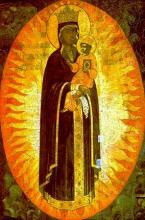 This Icon appeared in Moscow during the middle of the 18th Century in the household of a certain Nikolai Dimitrievitch Skripitsyn. A servant who was known as a “blessed” [i.e. Fool for Christ] woman once dreamed that there was an icon of the Most-holy Theotokos hidden in the stovepipe. The domestic servants did not pay any attention to her story about a vision in her sleep, until, the next day, a canvas scroll, bearing a large (about 2 x 1.5 meters) image of the Mother of God fell down onto the hearth. The right arm of the Mother of God bore a scorch mark, evidence that despite being in the fire, the Holy Icon miraculously had not been consumed by the flames. The precious Icon got its name, “Shestokovskaya” from the word shestok – i.e. canvas. The members of the household richly decorated the Icon, and accorded it great reverence. Shortly before his death, the master of the house gave it as a blessing to his children.
This Icon appeared in Moscow during the middle of the 18th Century in the household of a certain Nikolai Dimitrievitch Skripitsyn. A servant who was known as a “blessed” [i.e. Fool for Christ] woman once dreamed that there was an icon of the Most-holy Theotokos hidden in the stovepipe. The domestic servants did not pay any attention to her story about a vision in her sleep, until, the next day, a canvas scroll, bearing a large (about 2 x 1.5 meters) image of the Mother of God fell down onto the hearth. The right arm of the Mother of God bore a scorch mark, evidence that despite being in the fire, the Holy Icon miraculously had not been consumed by the flames. The precious Icon got its name, “Shestokovskaya” from the word shestok – i.e. canvas. The members of the household richly decorated the Icon, and accorded it great reverence. Shortly before his death, the master of the house gave it as a blessing to his children.
Because the heirs, uncertain as to whom the Miraculous Icon should belong, gave it to the church of the Sheltomezhi village, Tver Province, the Icon acquired its second name, the Sheltomezhskaya Icon. The ancient Icon, renowned as the source many miracles, was carried in processions of the Cross far beyond the boundaries of the Tver Diocese, in order to bring healing to the sick and those possessed by evil spirits.
The "Blessed Heaven" Icon
6/19 March
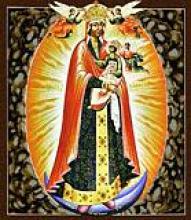 The Icon of the Mother of God known as the “Blessed Heaven” Icon is in the Iconostasis of the Cathedral Church of the Archangel in the Moscow Kremlin. We know that it used to be in Smolensk, and that it was translated to Moscow by Sophia, daughter of Lithuanian Prince Vitovt, at the time she married Prince Vasily Dmitrievitch (1389 - 1425) of Moscow. The Icon bears a full-length depiction of the Mother of God, with the Divine Infant on her left arm. Some people refer to this Icon as the “What shall we call thee” Icon of the Mother of God.
The Icon of the Mother of God known as the “Blessed Heaven” Icon is in the Iconostasis of the Cathedral Church of the Archangel in the Moscow Kremlin. We know that it used to be in Smolensk, and that it was translated to Moscow by Sophia, daughter of Lithuanian Prince Vitovt, at the time she married Prince Vasily Dmitrievitch (1389 - 1425) of Moscow. The Icon bears a full-length depiction of the Mother of God, with the Divine Infant on her left arm. Some people refer to this Icon as the “What shall we call thee” Icon of the Mother of God.
The Icon is celebrated on March 6 and on the Sunday of All Saints.
"Albazin" Icon "The Word Was Made Flesh"
9/22 March
In the winter of 1665-1666, a detachment of Cossacks from Nikifor in Chernigov established themselves in the heartland of the Orthodox civilization at the Amur River, on the legendary island of Albazino. Cossacks could not have imagined living in an unexplored land without spiritual nourishment provided by a priest; thus, Elder - Abbot Germogen set off with the Cossacks on their long journey. It was he who brought along to Albazino the holy miraculous Icon “The Word Made Flesh,” which later came to be known as the Albazino Icon.
In the mid 19th Century, the time came to establish Russian governance over Russia’s far-Eastern borders. People migrated to the newly explored lands from all over the enormous Russian Empire. Their great trek was fraught with great dangers and difficulties. Hoping on God’s mercy, the travelers intensified their prayers, and carried in their hearts the images of the miraculous icons with which they had been familiar from infancy back home. That enormous variety of icons found its grace-filled reflection in the holy Miraculous Albazino Icon of the Mother of God, the only one in that entire far-Eastern region, the Icon through which for many years the Queen of Heaven accompanied the first pioneers.
One hundred years ago, in 1902, with the blessing of the Most-reverend Nikodim (Bokov), visits by the Holy Albazino Icon to individual settlements at the request of the residents were expanded to greater journeys, encompassing wide regions of the Amur area, and became diocesan undertakings. Each year from that time on until the difficult years of the Revolution, the miraculous Icon was taken from the Annunciation Cathedral in late spring, and until mid-Autumn, would go in Processions of the Cross to visit a multitude of villages throughout the Amur land. The joy and inspiration it gave the people of Amur was enormous. Thus was the land of Amur blessed.
The reverence for the miraculous Icon among the Orthodox of Amur grew greater each year, until the Most-reverend Guriy (Burtasofsky), who administered the diocese beginning in 1885, decreed in the Autumn of that same year, that by order of the Holy Synod, a Feast of the Albazino Icon of the Mother of God was to be celebrated annually on March 9 (March 22 New Style). On that date, both in the Cathedral and in other churches of the diocese, Festal Liturgies and Molebens are served. From that point on, in the Annunciation Cathedral, the Akathist has been read before the Holy Miraculous Icon weekly.
The feast established in honor of the Holy Albazino Icon came into general usage, and for many residents of Blagoveschensk, weekly readings of the Akathist before the Icon became an essential part of their religious observance.
After its arrival in the God-preserved town of Blagoveschensk, the icon that had worked miracles over the centuries, gained ever-greater renown with each passing year for new miracles wrought through fervent prayers offered before it. Thus, already in the Fall of 1885, at the time its Feast day and the practice of weekly Akathists before it became established, the awful epidemics of diphtheria and scarlet fever that had been ravaging the town and its surrounding area, taking the lives of many people, first abated, and then disappeared altogether. Before, the appearance of black flags marking the homes of victims had terrified the populace. Through the intercession of the Most-pure Theotokos, and through fervent prayers to her, the deadly danger passed. In 1895, the miraculous icon worked miracles during an epidemic of plague that struck the town.
As the Holy Albazino Icon of the Mother of God, known as the “Word Made Flesh,” depicted the Mother of God bearing the Divine Infant in her womb, it was soon noted that the grace of Divine help was extended especially in response to fervent prayers for women who were pregnant and those in labor.
During the episcopacy of the Most-reverend Guriy, there developed traditions of having Processions of the Cross with the Miraculous Icon throughout the city. They would go in procession with the Holy Icon along the streets of Blagoveschensk, would enter the homes of those who were in need of support and healing, and would carry the Icon over those who were ill. Quite often, on these occasions, healing or easing of suffering would occur. Miracles wrought through the prayers of the faithful before the Miraculous Icon and during its visits to homes quickly became known to the Orthodox Christians not only in the city and its environs, but also far beyond throughout the Amur area.
Many copies of the Miraculous Icon were made before the Revolution. Some of them remained in the Amur area, while others were distributed throughout the Russian Empire.
St.Theodore or "Feodorovskaya-Kostromskaya" Icon
14/27 March
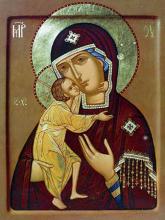 The earliest accounts of this icon appear in the 12th century, linked to the memory of the Holy Great-Martyr Theodore Stratelates, a warrior, who in the fourth century suffered and was beheaded for his faith in Jesus Christ. Tradition states Saint Theodore Stratelates brought this icon more than once to people after the devastation wrought by the Tatars. For this reason, its primary title is the Saint Theodore, or "Feodorovskaya," Icon.
The earliest accounts of this icon appear in the 12th century, linked to the memory of the Holy Great-Martyr Theodore Stratelates, a warrior, who in the fourth century suffered and was beheaded for his faith in Jesus Christ. Tradition states Saint Theodore Stratelates brought this icon more than once to people after the devastation wrought by the Tatars. For this reason, its primary title is the Saint Theodore, or "Feodorovskaya," Icon.
The icon became known as the "Feodorovskaya-Kostromskaya" Icon after the Dormition Cathedral, with a chapel in honor of Saint Theodore Stratelates, was built in Kostroma especially for it.
Once, as the Tatars were approaching Kostroma, Russian militia came out to meet them, carrying before them their holy Icon of the Mother of God. As the foes faced one another, between - them sped a mysterious rider. His purple mantel flapped in the breeze, and his golden shield glistened with a blinding light. The Russians recognized him to be the Holy Great-martyr Theodore Stratelates. Seized with fear, the Tatars ran from the field of battle. Thus was Kostroma saved.
This miracle-working icon is also linked in Russian history with the election of Michael Feodorovich Romanov to be tsar. After the lengthy time of troubles, an All-Russian Council was convened to choose a tsar, and emissaries were dispatched to the lpatiev Monastery (near Kostroma), where Michael Feodorovich had sought shelter, to ask him to accept the throne. The emissaries from Moscow brought with them the Vladimir Icon of the Mother of God, and-from Kostroma, they brought the Feodorovskaya icon as well. They appeared before the elder Martha, the mother of the young Michael, and asked her to permit her son to be tsar. His mothers refused at first, citing Michael's youth, so the Archbishop of Riazan' took the Icon of the Mother of God into his hands, and addressed Martha and Michael with the following words: Why did the icons of the Most Holy Mistress travel with us on a long journey. If you will not listen to us, then for the sake of the Mother of God, be disposed towards mercy, and do not anger the Lord God. The elder Martha could not stand against such words. She fell to her knees before the Feodorovskaya Icon and said, Thy will be done, O Lady. I convey my son into thy hands. Set him on the path of truth, for the good both of himself and [our] native land! Thus, before this icon was chosen the first tsar of the house of the Romanovs.
On the 300th anniversary of the House of the Romanovs, in Tsarskoye Selo (now called Puskhin), there was erected (1909-1912) the "Feodorovsky Sovereign's Cathedral," in memory of the appearance of the Feodorovskaya Icon of the Mother of God. It is quite possible that the image now in the Church of the Resurrection of Christ in the Wood, which serves as the cathedral in Kostroma, is the "original" image of this holy icon. If so, it is one of those rare miracle-working and much-revered ancient icons that remain in the Church and not in some museum.
In terms of iconography, it is an icon of ancient Byzantine origin, of the type known as Tender Mercy, and closely resembles the Vladimir Icon of the Mother of God. Its main distinguishing feature is the bare left foot of the Infant Jesus Christ, which the Mother of God holds in her right hand.
PARISH LIFE
RECENT VIDEOS
Address of our Cathedral
Subscribe to our mailing list
While all the materials on this site are copyrighted, you may use them freely as long as you treat them
with respect and provide attribution on the Russian Orthodox Cathedral of St.John the Baptist of Washington DC.



